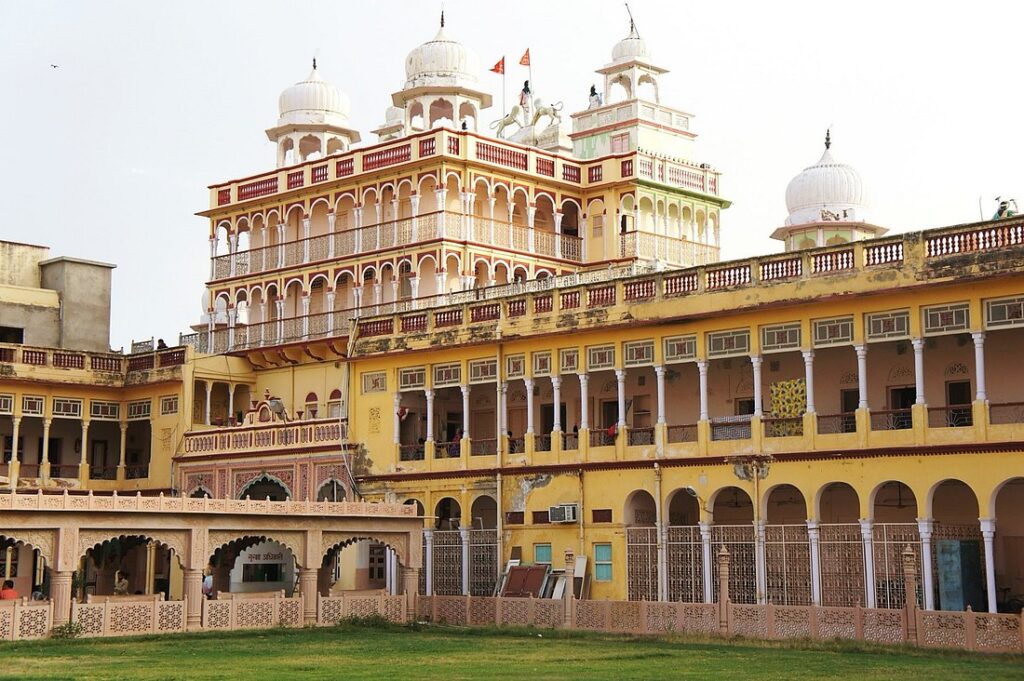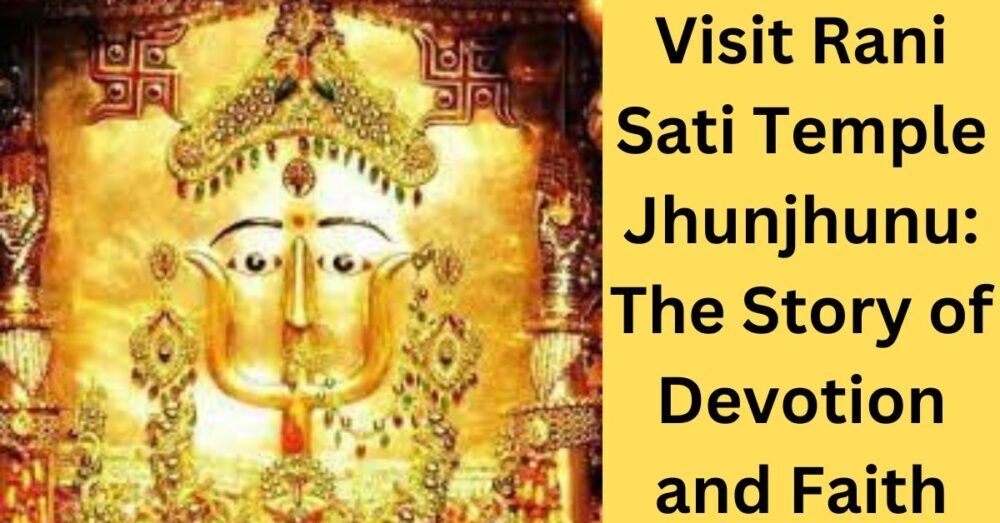A holy pilgrimage place known as Rani Sati Dadi Mandir Jhunjhunu is situated in the Indian state of Rajasthan. It is dedicated to Rani Sati, a Hindu goddess also known as Narayani Devi. Thousands of followers come to the temple every day to offer prayers and seek the goddess’ blessings.

Contents
- 1 History and Legend of Rani Sati Dadi
- 2 Architecture and Design of Rani Sati Dadi Mandir Jhunjhunu
- 3 Festivals and Celebrations
- 4 Significance and Beliefs of Rani Sati Dadi
- 5 Visiting Rani Sati Temple Jhunjhunu
- 6 FAQs
- 6.1 What is the history of Rani Sati Dadi Mandir Jhunjhunu?
- 6.2 What is the architecture of the Rani Sati Dadi Mandir Jhunjhunu?
- 6.3 What is Rani Sati Dadi Mandir Jhunjhunu?
- 6.4 What is the significance of Rani Sati Dadi Mandir Jhunjhunu?
- 6.5 What are the timings of the Rani Sati Dadi Mandir Jhunjhunu?
- 6.6 What is the best time to visit the Rani Sati Dadi Mandir Jhunjhunu?
- 6.7 What is the dress code to be followed while visiting the temple?
- 6.8 Are there any accommodation options near the Rani Sati Dadi Mandir Jhunjhunu?
- 6.9 Is photography allowed inside the Rani Sati Dadi Mandir Jhunjhunu?
- 6.10 What are the nearby tourist attractions of Rani Sati Dadi Mandir Jhunjhunu?
- 7 Conclusion
History and Legend of Rani Sati Dadi
The history of Rani Sati Jhunjhunu dates back to the 16th century, when a Rajput queen named Rani Sati committed sati, which is a practice where a wife immolates herself on her husband’s funeral pyre. According to legend, Rani Sati’s husband was killed in a battle, and she decided to end her life to join him in death.
The temple was built in honor of Rani Sati dadi and became a popular pilgrimage site over time. The temple complex is spread over an area of 7 acres and has several shrines dedicated to various deities.
Architecture and Design of Rani Sati Dadi Mandir Jhunjhunu

The architecture of the Rani Sati Dadi Mandir Jhunjhunu is a fine example of Rajasthani style. The main temple is a three-story building made of white marble, with intricate carvings and engravings. The temple has a large dome at the top, which is adorned with gold and silver.
The complex also has several smaller temples dedicated to different deities, including Lord Hanuman, Lord Shiva, and Lord Ganesha. The temple also has a large hall for prayer and meditation, which can accommodate thousands of devotees.
Festivals and Celebrations
The Rani Sati Dadi Mandir Jhunjhunu is known for its grand celebrations during festivals and special occasions. The temple celebrates Navratri, Diwali, Holi, and other festivals with great pomp and show. Thousands of devotees flock to the temple during these festivals to seek blessings and participate in the festivities.
Significance and Beliefs of Rani Sati Dadi

The Rani Sati Dadi Mandir Jhunjhunu is considered to be one of the most sacred places for Hindus. Devotees believe that worshipping Rani Sati can bring prosperity, happiness, and success in their lives. The temple is also known for fulfilling the wishes of devotees who come with a pure heart and a strong belief in the goddess.
More to Visit – Salasar Balaji Temple
Visiting Rani Sati Temple Jhunjhunu
Visiting Rani Sati Dadi Mandir Jhunjhunu is a unique experience that cannot be missed. The temple is open to visitors from 5:00 am to 10:00 pm every day, and the best time to visit is during festivals and special occasions.
The town of Jhunjhunu also has several other attractions, including ancient temples, forts, and havelis, which are worth exploring.
More to Visit – Rajasthan’s Top 10 Tourist Hotspots: Uncovering the Magic of the Land of Kings
FAQs
What is the history of Rani Sati Dadi Mandir Jhunjhunu?
Rani Sati Rani Sati Dadi Mandir Jhunjhunu is dedicated to Rani Sati, a Rajput queen who committed sati in the 16th century.
What is the architecture of the Rani Sati Dadi Mandir Jhunjhunu?
The temple is a three-story building made of white marble, with intricate carvings and engravings.
What is Rani Sati Dadi Mandir Jhunjhunu?
Rani Sati Dadi Mandir Jhunjhunu is a popular Hindu temple dedicated to the goddess Rani Sati, located in the city of Jhunjhunu in Rajasthan, India.
What is the significance of Rani Sati Dadi Mandir Jhunjhunu?
The temple is considered to be a powerful source of positive energy and is believed to grant wishes and fulfill desires of devotees who come here to seek the blessings of the goddess.
What are the timings of the Rani Sati Dadi Mandir Jhunjhunu?
The temple is open from 5:00 AM to 9:00 PM every day. However, the timings may vary during special occasions and festivals.
What is the best time to visit the Rani Sati Dadi Mandir Jhunjhunu?
The temple can be visited throughout the year. However, the months of October to February are considered the best time to visit due to the pleasant weather conditions.
What is the dress code to be followed while visiting the temple?
Visitors are expected to dress modestly and avoid wearing revealing clothes. It is recommended to wear traditional Indian attire while visiting the temple.
Are there any accommodation options near the Rani Sati Dadi Mandir Jhunjhunu?
Yes, there are several accommodation options available near the temple, including budget hotels and guesthouses.
Is photography allowed inside the Rani Sati Dadi Mandir Jhunjhunu?
Photography is allowed inside the temple, but visitors are advised to seek permission before clicking photographs.
What are the nearby tourist attractions of Rani Sati Dadi Mandir Jhunjhunu?
There are several tourist attractions located near the temple, including the Khetri Mahal, Badalgarh Fort, and the Tal Chhapar Wildlife Sanctuary.
Conclusion
Rani Sati Dadi Mandir is a place of great devotion and faith, where thousands of devotees come to seek blessings and offer prayers. The temple’s rich history, magnificent architecture, and spiritual significance make it one of the most important pilgrimage sites in India.
More to Read – Rani Sati Temple
